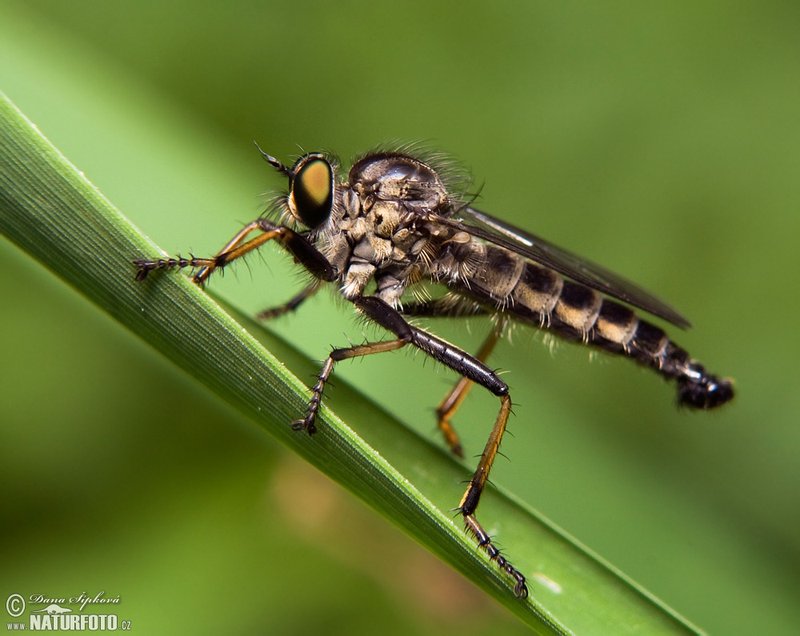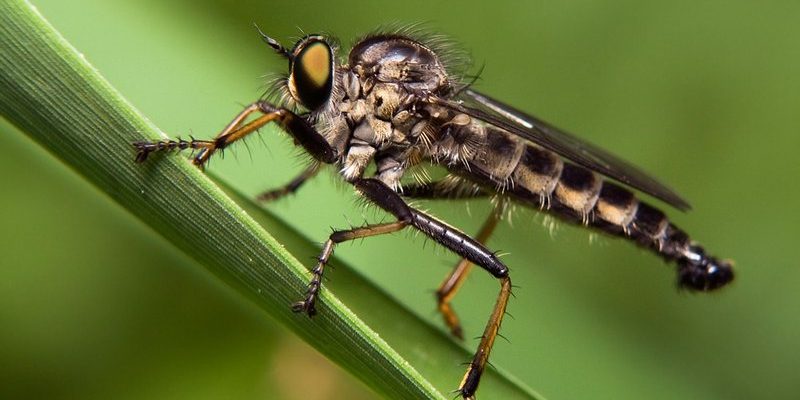
Imagine a tiny ninja zooming through the air, snatching up its prey with lightning speed. That’s the Robber Fly for you! These remarkable insects combine skill, agility, and a predatory instinct that’s nothing short of fascinating. Found in various habitats around the world, robber flies are not just ordinary insects; they play an essential role in our ecosystem as hunters.
But what exactly makes these flies so special? From their unique hunting techniques to their striking appearance, there’s a lot to uncover about these stealthy predators. Let’s dive deeper into their world and learn what makes the robber fly stand out in the vast insect kingdom.
What is a Robber Fly?
Robber flies belong to the family Asilidae, which encompasses over 7,000 species globally. They are known for their distinct appearance: long legs, stout bodies, and large eyes that give them a fierce look. Typically, they are grayish or brownish, which helps them blend into their surroundings. Another interesting feature is their strong, piercing mouthparts, perfect for consuming their prey. These insects are highly specialized, with many species displaying unique traits to adapt to their environments.
As adults, robber flies predominantly feed on other insects. They are infamous for their hunting prowess, often preying on bees, wasps, and even other flies. With a combination of stealth and speed, they ambush their targets, making them effective predators. In fact, their hunting strategy is so successful that they can sometimes be seen snatching up prey mid-flight, somewhat like a hawk swooping down on a mouse!
It’s also worth noting that the lifecycle of a robber fly is compelling. They undergo complete metamorphosis, starting as eggs laid on plants. Once hatched, the larvae live in the soil or decaying organic material, where they can also be formidable predators, preying on other insect larvae.
Physical Characteristics
The physical characteristics of robber flies are what set them apart from other insects. With their elongated bodies that can range from about 5 to 40 millimeters, you can find them in various sizes, depending on the species. Their striking wings are often clear with dark markings, and their eyes are especially large, providing excellent vision to spot prey from a distance.
One of the most intriguing aspects of a robber fly’s anatomy is its mouth. They possess a specialized set of mouthparts that allow them to pierce the exoskeletons of their prey, which is how they consume them. This feature is similar to that of a mosquito, but instead of feeding on nectar or blood, they are designed to devour other insects, making them quite the fierce hunter.
Additionally, robber flies exhibit remarkable flight abilities. They are known for their speed and agility, which allows them to effectively pursue and capture prey. The way they hover in mid-air to stalk insects is reminiscent of a drone—steady, focused, and ready to strike.
Habitat and Distribution
Robber flies are quite versatile when it comes to habitat. You can find them in gardens, grasslands, meadows, forests, and even deserts. They prefer areas rich in vegetation where they can easily ambush their prey. The presence of flowers also attracts other insects, making it a prime hunting ground for these flies.
In terms of distribution, robber flies are present on every continent except Antarctica. They thrive in diverse climates, ranging from tropical regions to temperate zones. This adaptability showcases their resilience and ability to survive in different environments, allowing them to become a common sight in many ecosystems.
Interestingly, certain species of robber flies have specific habits that may dictate their preferred habitat. For instance, some may prefer forested areas, while others are more commonly found in open spaces. This variability highlights the ecological roles they play, adapting to different environments while fulfilling their roles as predators.
Diet and Hunting Behavior
The diet of robber flies is primarily composed of other insects, making them carnivorous predators. They have been observed hunting various prey, including bees, beetles, and even other flies. One fascinating aspect of their hunting behavior is their ambush technique. They often perch on a branch or stalk, patiently waiting for unsuspecting prey to come into range.
Once a target is spotted, the robber fly launches into action, darting towards its prey with remarkable speed. With a quick strike, it uses its sharp mouthparts to pierce the insect’s exoskeleton and inject a toxic saliva that begins to digest the prey from the inside out. This method not only ensures a nutritious meal but also saves them the effort of tearing apart tough exoskeletons.
You might be wondering how they avoid becoming prey themselves. Robber flies have developed several defensive tactics. Their speed and agility allow them to evade larger predators, while their cryptic coloration helps them blend into their surroundings. Additionally, some species can mimic the appearance of more dangerous insects to deter potential threats.
Life Cycle and Reproduction
The life cycle of a robber fly is quite fascinating. It starts when the female lays her eggs on vegetation or in the soil. After about one to two weeks, the larvae hatch and begin to live in the soil or in decaying organic matter. During this stage, they are just as predatory as their adult counterparts, feeding on other insect larvae and organic material.
As they grow, these larvae will undergo several molts before ultimately pupating. The pupal stage can take anywhere from a few weeks to a couple of months, depending on environmental conditions. After emerging as adults, they take to the skies, ready to start the cycle all over again.
Robber flies typically mate in the spring and summer when temperatures are warmer and food sources are abundant. The male often performs courtship displays to attract a female, which involves intricate flight patterns and even presenting gifts in the form of prey. This display not only impresses the female but helps ensure the survival of their species.
Conservation Status
Many species of robber flies are abundant and don’t currently face significant threats. However, like many insects, they can be affected by habitat loss due to urban development, climate change, and pesticide use. These factors can reduce their populations by destroying their habitats and food sources.
Conserving the natural habitats where robber flies thrive is essential for maintaining their populations. Supporting local biodiversity efforts and reducing pesticide use can significantly impact these remarkable insects’ survival. By planting native flowers and creating environments conducive to various insects, we can help support the entire ecosystem, including robber flies.
Moreover, educating people about the importance of these predators can also encourage preservation efforts. Recognizing their role in controlling pest populations can help people appreciate the value of having robber flies around.
Fascinating Facts About Robber Flies
| Size: | 5 to 40 mm in length |
| Habitat: | Gardens, grasslands, forests, and deserts |
| Diet: | Insects such as bees, wasps, and other flies |
| Speed: | Extremely fast, capable of darting to catch prey mid-air |
| Lifespan: | 1 to 2 years, depending on the species |
Robber Fly Species
There are numerous species of robber flies, each with unique characteristics and hunting methods. Some of the more well-known species include the Black Robber Fly (Dioctria spp.), known for its unique black coloration, and the Giant Robber Fly (Holcocephala spp.), which can grow up to 40 mm in length.
Each species adapts its hunting style based on its environment and prey availability. For instance, some may prefer hunting in open fields where they can spot prey easily, while others might thrive in denser vegetation.
Understanding the diversity among robber fly species not only highlights their adaptability but also emphasizes the importance of conservation efforts to protect their varied habitats. By preserving their environments, we help ensure the survival of these remarkable insects and their diverse species.
Safety Considerations
While robber flies are fascinating creatures, it’s essential to approach them with caution. Their bite can be painful, as they are adept at piercing through skin if provoked. However, they are not aggressive and typically only bite when they feel threatened.
If you happen to encounter a robber fly in your garden or while hiking, it’s best to observe from a distance. Their impressive hunting skills and unique behaviors are best appreciated without direct interference. Remember, they’re doing their part to balance the ecosystem by controlling insect populations.
Educating others about the important role robber flies play can lead to a greater appreciation for these insects. So, whether you spot one in your backyard or in the wild, take a moment to admire this little ninja of nature!
FAQ
Are robber flies dangerous to humans?
Robber flies are not inherently dangerous to humans. While they can bite if threatened, their primary focus is on hunting smaller insects. Their bites can be painful but are not toxic. Observing them in their natural habitat is usually safe as long as you give them space.
How do I identify a robber fly?
Robber flies are typically identified by their long, slender body, large eyes, and distinctive coloration, which can range from gray to brown. They also possess unique mouthparts designed for piercing prey. If you see a fly hovering stealthily while stalking other insects, there’s a good chance it’s a robber fly.
Do robber flies have any natural predators?
Yes, robber flies do have natural predators, including birds and larger insects. Birds are particularly good at spotting these flies due to their size and behavior. However, robber flies’ speed and agility help them evade many potential threats.
Can robber flies be found in urban areas?
Absolutely! Robber flies can adapt to various environments, including urban settings. You might find them in parks or gardens where their prey, like other insects, is abundant. Planting native flowers can help attract these beneficial predators to your urban garden.
What role do robber flies play in the ecosystem?
Robber flies play a crucial role in controlling insect populations, as they primarily feed on pests like wasps and bees. By managing these populations, they help maintain balance in the ecosystem. Their predatory nature contributes to a healthy environment, making them important allies in nature.
How long do robber flies live?
The lifespan of a robber fly varies by species but typically ranges from one to two years. The duration can be influenced by environmental factors, food availability, and predation rates. During their adult life, they focus on hunting and reproduction.
Are robber flies beneficial for gardens?
Yes, robber flies are quite beneficial for gardens! They help control pest populations by preying on harmful insects, making them natural pest managers. Planting flowers that attract robber flies can enhance biodiversity and promote a healthier garden ecosystem.
How fast can a robber fly fly?
Robber flies are incredibly fast fliers, often reaching speeds comparable to that of a hummingbird. Their agility allows them to maneuver quickly mid-air, which is essential for successfully catching other insects. Their speed is one of their greatest assets in the wild.
Do robber flies only hunt in the daytime?
Most robber flies are diurnal, meaning they are primarily active during the day. Their excellent vision and hunting skills are adapted for daylight hours when their prey is also active. However, some species may exhibit crepuscular behavior, being active during dawn or dusk.
How can I attract robber flies to my garden?
To attract robber flies to your garden, you can plant a variety of native flowering plants that provide food for their prey. Creating a diverse environment with different heights and structures can also make it more inviting. Avoiding the use of pesticides will help ensure a healthy habitat for them.

